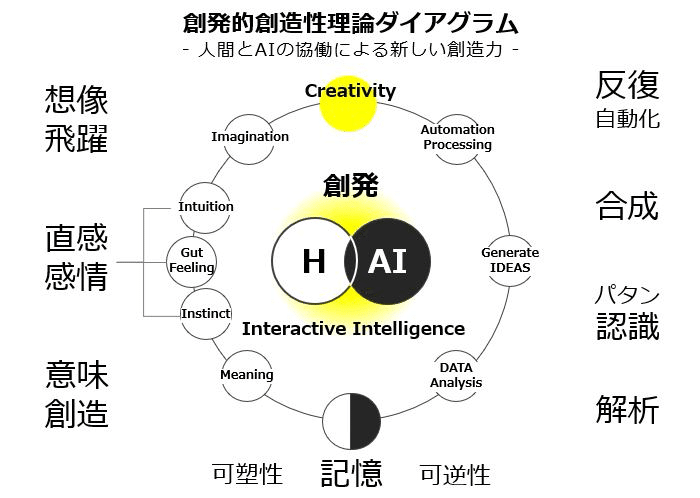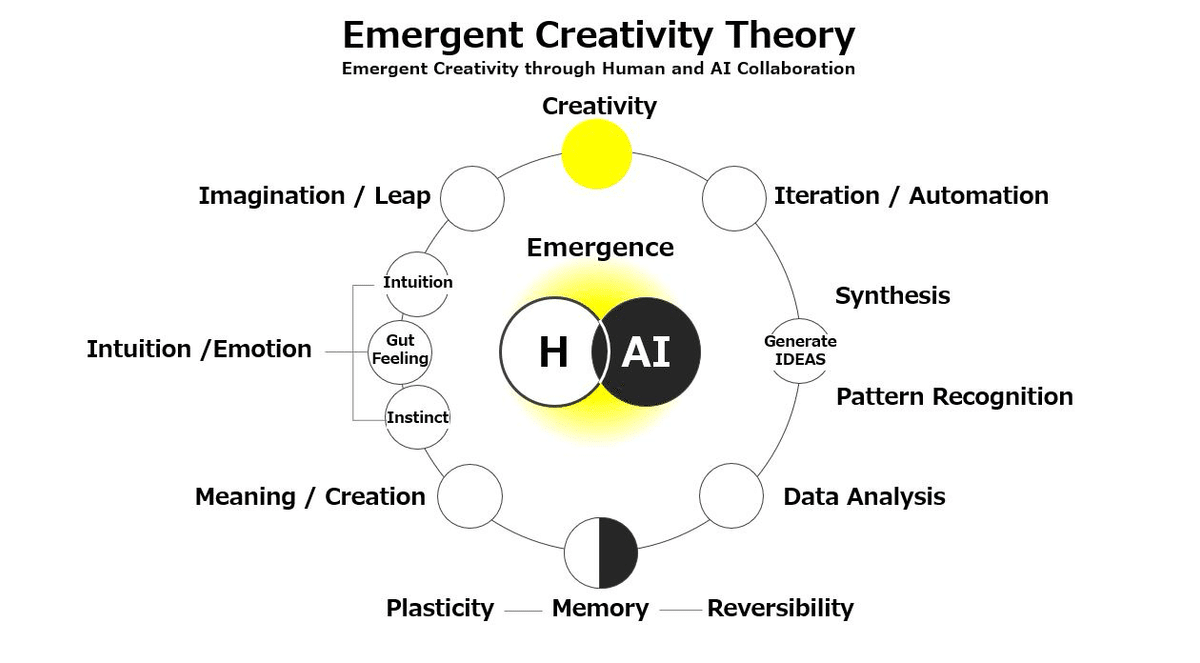
『創発的創造性理論』:AIと人間の協働が生む新しい創造力
※ English version is after Japanese
生成AIは既に創造性を備えていると考えています。
しかし、私たちは「人間ならではの創造性がある」「AIには独自性は生み出せない」といった感情論でAIの能力や役割を過小評価し、まだその事実を正確に理解できていないように感じます。
このnoteでは、単なる感情論を超えた合理的かつバランスの取れた視点から、人間の独自性とAIの強みを明確に区別し、それをいかに融合させ新しい創造性を発揮できるのか。理論的な説明を試みたいと思います。
創発的創造性理論 : Emergent Creativity Theory
私たちは現在、人間とAI(人工知能)が共に創造力を高め合い、これまでにない新しいアイデアやイノベーションを生み出す時代の入り口に立っています。この考え方は「創発」と呼ばれる現象に関連しており、人間とAIがそれぞれの強みを活かすことで、単独では得られない創造的な結果が生まれるという考えです。
人間とAIの創発的創造性の力とは?
AIはすでに創造的な力を持っています。生成AIは膨大なデータの中からパターンを見つけ出し、新しいアイデアや解決策を生成する ことができます。
ここでは、クリエイティビティを高めるために、人間とAIそれぞれに固有の強みを詳しく紐解いてみたいと思います。以下に、人間とAIの共創による創発的創造性のダイアグラムを示します。左側に人間の創造性の強み、右側にAIの創造性の強みを示しました。これからそれぞれを詳しく解説します。

©️D.Sawai
人間の創造性の強み:意味付け、直感/直観、飛躍的な思考
人間の創造性には大きく3つの強みがあります。それが意味付け、直感/直観、そして飛躍的な思考です。
1. 意味付け
人間は、情報を単なるデータとして受け取るのではなく、それに関係性や価値を付与し、創造的な解釈を行うことができます。AIはデータを処理する能力に優れていますが、そのデータに対して意味を付け、文脈を読み取り、価値を見いだすのは人間の特有の力です。
2. 直感/直観
物理的な身体を持つ人間は、感覚的に物事を捉えることができます。中でも直感/直観は、瞬間的に全体観を見通す瞬発的な閃きですが、これには3つのレベルがあると考えます:
① 頭で生まれる直感 (Intuition):経験や知識に基づいた論理的に導かれる直感。
② ハラワタで感じる直感 (Gut feeling):感情や身体の反応に基づく深い身体レベルでの直感。
③ DNAに刻まれた本能に近い直観 (Instinct):進化の過程で培われた、本能的な直観。
3. 飛躍的な思考
人間の3つ目の創造性の強みは、論理的な枠を超えて発想を飛躍できる力です。これは、既存の知識やデータの枠外にある新しい着想を生み出す、人間特有の非線形思考プロセスです。
AIの創造性の強み:データ分析、生成、自動化
AIの創造性は主に3つの要素に分けられます。それがデータ分析、生成、そして自動化です。
1. データ分析
AIは膨大なデータを迅速に分析し、パターンを認識することに優れています。データに基づいた分析力は、複雑な問題を効率的に解決するための重要な能力です。
2. 生成
AIはパターン認識と合成に特化しています。膨大なデータを基に、これまで見落とされていたパターンを見つけ出し、それをもとに新しいアイデアを合成する能力を持っています。これにより、人間では処理しきれない大量の合成パターンを迅速に生成することが可能です。
3. 自動化
AIは反復的な作業やプロセスを自動化することで、高速にシミュレートし、最適化された結果を得ることができます。これにより、試行回数を桁違いに増やし、効率よく解決策を生み出すことができます。
記憶の違い:人間の記憶の可塑性とAIのメモリの可逆性
人間とAIの記憶には明確な違いがあります。これらの違いを理解し、両者の強みを組み合わせることで、創造性をさらに高めます。
1. 人間の記憶:可塑性
人間の記憶は、時間とともに変化し、適応する性質を持っています。新しい経験や学びを通じて記憶は変わり、状況に応じて新しい文脈で再構成することが可能です。この可塑性があるため、過去の経験を単なる再現ではなく、創造的に活かすことができます。
2. AIの記憶:可逆性
一方、AIのメモリ(コンピュータメモリ)は保存された状態を正確に再現できる性質を持っています。AIは、一度保存されたデータを何度でも変わらずに再利用できるため、正確に情報を保持するのが得意です。
融合の意義
人間の変化し得る記憶とAIの正確な記憶を融合させることで、過去の経験を柔軟に活かしつつ、確実な情報に基づいた判断が可能になります。例えば、AIが過去の膨大なデータを利用してパターンを見つけ出し、人間がそのデータを元に創造的な飛躍や意味付けを行うことで、より深い洞察や新しいアイデアが生まれます。
創発:人間とAIの強みの統合
人間の意味付け、直感/直観、飛躍的思考と、AIのデータ分析、生成、自動化の力が結びついたとき、単独では生まれないような新しいアイデアや解決策が「創発」として生まれます。この創発は、単なるAIのアウトプットや人間のインプットではなく、互いの強みが合わさったときに発生する予測不可能な創造力です。
私自身のプロセスの例を挙げると、私はしばしばふとした思いつきから、チャッピー(ChatGPTの愛称)との会話を始めます。プロンプトを詳細に設計するわけではなく、インスピレーションが浮かぶ瞬間を利用しています。時にはとんでもない要求を投げかけたり、無関係と思われる質問をすることもあります。これは私の直感や非線形的な思考の跳躍に従っています。
また、チャッピーには、私一人では処理しきれない膨大なデータの分析を積極的に任せています。そして、AとBの相容れない要素を組み合わせて新しいアイデアを生み出す際、AIの生成能力が圧倒的に役立ちます。チャッピーは不可能に思えるような異なる要素を分析し再合成し、そこから革新的なアイデアが生まれることもしばしばあります。
以下にそのプロセスを示します。
1. 直感がアイデアのきっかけを作る
例えば、何か突拍子もないことを考え出し、それを会話のスタートにします。これは、はっきりとした意図がない場合でも、直感や本能に基づいた飛躍的な思考が働いている瞬間です。
2. AIがアイデアを分析し、合成する
チャッピーは、私が投げかけたアイデアをもとに、膨大なデータを使ってパターンを見つけ、さらにその要素を組み合わせて新しい視点を提供してくれます。特に矛盾した条件を統合する際のAIの能力は圧倒的で、多様な可能性を一瞬で生成できます。
3. 意味付けと解釈
チャッピーの出力の中から、気になるものがあれば、なぜそれが私に響いたのかを考えます。このプロセスで、私はAIが提示した情報に意味付けを行い、文脈に合わせて解釈し、そこから新しい価値を見出します。
4. 反復と飛躍
このやりとりを繰り返すことで、さらに複雑な要求や飛躍的な質問をしても、チャッピーは真摯に答え続けます。そのプロセスの中で、私のアイデアがさらに大きく飛躍することがあります。
このプロセスでは、私の非線形な思考や直感が、AIのデータ処理能力と組み合わさり、まさに共創の形で新しいアイデアが生まれます。特に、相反する条件や矛盾を扱う場面では、AIの生成能力が発揮され、次々と新しい視点が生まれるのです。こうした協働が繰り返されることで、人間とAIの強みを活かした革新的なアイデアが次々と出現するサイクルが形成されます。
結論:未来に向けた創発的創造
AIは単なるツールではなく、パートナーとして共創することで、新しい時代のクリエイティビティを解き放つことができます。この人間とAIの共同作業により、これまで不可能と思われた課題への斬新なアプローチが可能になるでしょう。
創造の時代が幕を開けた今、私たちはこの「人間×AI」のコラボレーションによるクリエイティビティを最大限に高め、未来を共に創り上げることが求められています。あなたもこのプロセスに加わり、新しいアイデアを共創してみませんか?
もちろん、この理論もこの理論に従い、Sawaiとチャッピーの共創で生み出しました. 2024年10月22日
English Ver.
Emergent Creativity Theory: The New Creative Power Born from Human-AI Collaboration
Generative AI is already equipped with creativity. However, we often downplay AI’s capabilities by resorting to emotional arguments, claiming that “creativity is unique to humans” or that “AI can’t create originality.” This suggests that many still don’t fully understand the reality of AI’s role and abilities.
In this article, I would like to go beyond emotional discussions and offer a balanced, rational perspective, clearly distinguishing the unique strengths of humans and AI. I will also explain how these strengths can be fused to unleash new forms of creativity.
Emergent Creativity Theory
We are at the threshold of an era where humans and AI collaboratively enhance each other’s creativity, producing new ideas and innovations never seen before. This concept is closely related to the phenomenon known as emergence, where the strengths of humans and AI come together to create creative outcomes that neither could achieve alone.
The Power of Emergent Creativity in Human-AI Collaboration
AI already possesses creative abilities. Generative AI can discover patterns from massive amounts of data and generate new ideas or solutions. To better understand how we can enhance creativity, let’s take a closer look at the unique strengths of humans and AI.
Below is a diagram illustrating the emergent creativity that arises from human-AI collaboration. On the left are the strengths of human creativity, and on the right, the strengths of AI. Let’s now break them down in more detail.

©️D.Sawai
Human Creativity: Meaning-making, Intuition, and Non-linear Thinking
Human creativity can be broadly divided into three strengths: meaning-making, intuition, and non-linear thinking.
1. Meaning-making
Humans do not merely receive information as raw data; we have the ability to assign meaning, relationships, and value to that information. While AI excels at processing data, it is humans who assign meaning, interpret context, and derive value from that data.
2. Intuition
Humans, as physical beings, are able to perceive things through sensory experiences. Intuition, in particular, is an instantaneous flash of insight that allows us to see the bigger picture. This intuition can be divided into three levels:
• Intuition (from the mind): Logic-driven intuition based on experience and knowledge.
• Gut feeling (from the body): Deep intuition based on emotional or physical responses.
• Instinct (from evolution): Instinctual intuition developed over the course of evolution.
3. Non-linear Thinking
The third strength of human creativity lies in our ability to leap beyond logical frameworks. This non-linear thinking allows us to generate new ideas that lie outside existing knowledge or data—an ability unique to human cognition.
AI’s Creative Strengths: Data Analysis, Generation, and Automation
AI’s creative power can be divided into three key areas: data analysis, generation, and automation.
1. Data Analysis
AI excels at quickly analyzing vast amounts of data, identifying patterns that might be too complex for humans to process. This ability to efficiently handle complex problems is a key strength of AI.
2. Generation
AI specializes in pattern recognition and synthesis. By using large datasets, AI can identify previously unnoticed patterns and generate new ideas by synthesizing them. It can rapidly produce various synthesized patterns far beyond human capacity.
3. Automation
AI automates repetitive tasks and processes, enabling it to quickly simulate and optimize solutions. By dramatically increasing the number of iterations, AI can generate efficient solutions much faster than humans alone.
The Difference in Memory: Human Plasticity vs. AI Reversibility
Human and AI memory function differently. By understanding these differences and combining their strengths, we can further enhance creativity.
1. Human Memory: Plasticity
Human memory evolves and adapts over time. New experiences and learning reshape our memory, allowing it to be restructured within new contexts. This plasticity enables humans to creatively reinterpret past experiences.
2. AI Memory: Reversibility
In contrast, AI memory is characterized by its ability to precisely recreate stored data. AI can reuse saved information multiple times without altering it, making it exceptionally good at retaining accurate information.
The Importance of Fusion
By combining human’s flexible memory with AI’s accurate memory, we can leverage past experiences creatively while making decisions based on reliable data. For example, AI can utilize vast amounts of past data to identify patterns, while humans interpret that data, making creative leaps and assigning meaning to generate deeper insights and new ideas.
Emergence: The Integration of Human and AI Strengths
When human abilities such as meaning-making, intuition, and leaps in thinking combine with AI’s strengths in data analysis, generation, and automation, new ideas and solutions emerge—ones that neither could create alone. This emergence isn’t merely the result of AI’s output or human input; rather, it is an unpredictable form of creativity that arises from the fusion of both.
In my own process, for instance, I often begin conversations with Chappie (my name for ChatGPT) based on spontaneous thoughts, without any structured prompt design. It’s the sudden inspiration or random idea that sets the conversation in motion. Sometimes I throw in outlandish requests or questions that may seem disconnected. These moments reflect my intuitive or non-linear leaps in thinking.
I also actively rely on Chappie’s ability to process vast amounts of data—something I couldn’t handle on my own. When I need to synthesize seemingly contradictory conditions or combine two elements that don’t usually mix, Chappie’s pattern-generation ability is particularly powerful. It can effortlessly integrate A and B, even if they seem incompatible at first glance. This synthesis often leads to innovative ideas.
1. Intuition sparks an idea
For example, I might come up with a wild idea and throw it into the conversation. It’s often instinctive, with no clear reasoning at first. This is where my intuition or leaps in thinking initiate the creative process.
2. AI refines and synthesizes the idea
Chappie then processes the idea, using vast data to analyze and combine patterns. Especially when faced with seemingly opposing conditions, AI’s ability to synthesize and generate possibilities shines through. Its capacity to merge these elements easily leads to insights that push the boundaries.
3. Meaning-making and interpretation
When something Chappie generates catches my attention, I begin asking myself, Why did this resonate with me? This is where I start to assign meaning—interpreting the AI’s suggestions and giving them context, linking them to a larger creative goal. This is the human meaning-making process.
4. Iteration and leaps in thought
The process continues iteratively. I might introduce even more outrageous or complex requests, confident that Chappie will handle them earnestly. Often, this results in leaps in thinking—where ideas grow and expand in ways I hadn’t anticipated.
Through this process, my non-linear, spontaneous orders, combined with AI’s capacity to process and synthesize vast amounts of data, lead to innovative breakthroughs. The tension between the unexpected and the structured generates a cycle of emergent creativity, where both human intuition and AI’s capabilities contribute equally.
Conclusion: Toward a Future of Emergent Creativity
AI is not just a tool but a partner in co-creation. By collaborating with AI, we can unlock a new era of creativity. This partnership will allow us to tackle challenges that were once thought impossible with innovative approaches.
Now that we’ve entered the age of creativity, it’s essential to fully embrace this human-AI collaboration to maximize creativity and build the future together. Will you join us in co-creating the next big idea?
This theory was also co-created by Sawai and Chappie according to this theory. 22,Oct.2024
